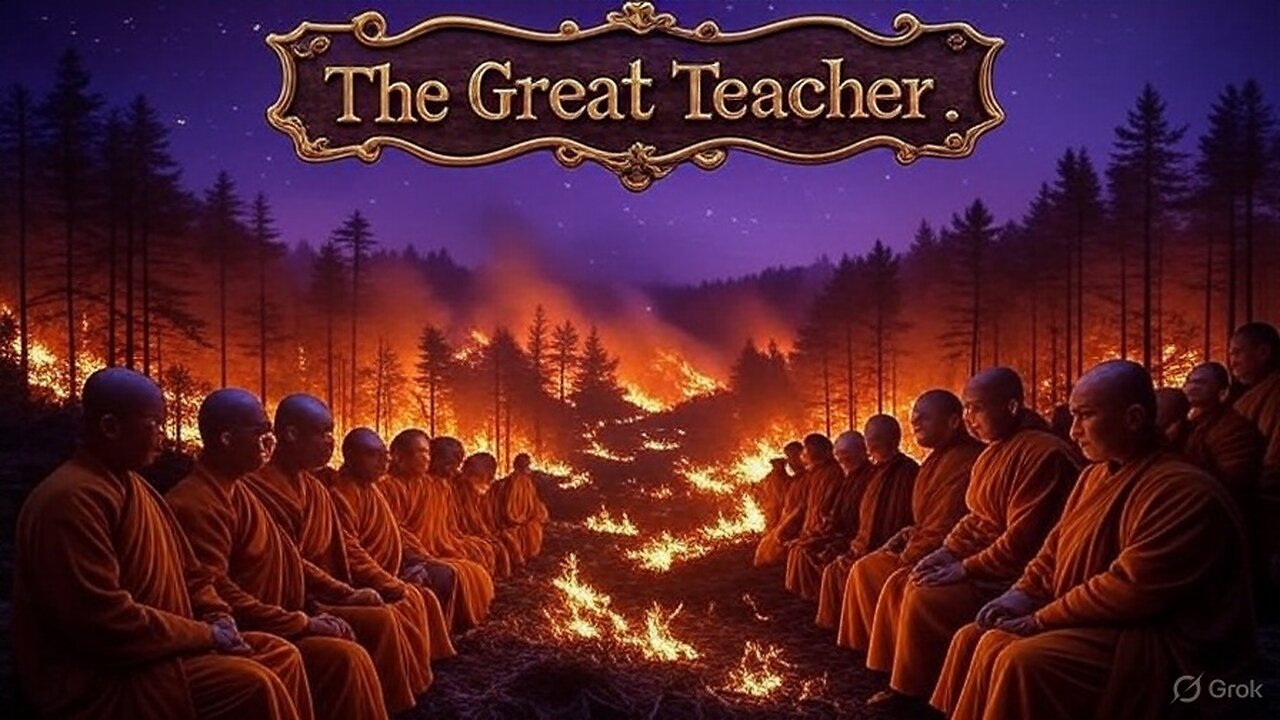Premium Only Content

Alan Watts: The Great Teacher of Non-Duality and Zen Philosophy
The Great Teacher: Alan WattsIn the heart of an ancient forest, where towering trees stand as silent sentinels, a raging, uncontrollable fire sweeps through, its flames licking at the bark with relentless fury. The air is thick with smoke, yet beneath this chaos, a group of Buddhist monks sits in tranquil meditation, their orange robes a stark contrast against the inferno. Above them stretches a surreal, star-filled purple sky, a celestial canopy that blends day and night into a timeless expanse. This striking scene serves as the visual allegory for The Great Teacher: Alan Watts, a profound exploration of the life, teachings, and legacy of one of the 20th century’s most influential philosophers and spiritual interpreters—Alan Watts.Born on January 6, 1915, in Chislehurst, England, Alan Wilson Watts emerged from a modest background to become a bridge between Eastern mysticism and Western intellectualism. His journey began with an early fascination with the natural world and a curiosity about the deeper questions of existence, sparked by a chance encounter with a Chinese scroll at the age of seven. This moment ignited a lifelong passion for Asian philosophies, particularly Buddhism and Taoism, which would later define his work. By his teenage years, Watts had already begun exploring the writings of mystics and philosophers, a pursuit that led him to the study of Zen Buddhism—a tradition that would become central to his identity.The imagery of the forest fire in The Great Teacher symbolizes the transformative power of Watts’ teachings. Just as fire consumes and reshapes the landscape, Watts’ ideas challenged conventional Western thought, urging listeners to reconsider their perceptions of reality, self, and society. The monks, observing with serene detachment, embody the Zen principle of non-attachment—a cornerstone of Watts’ philosophy. Their presence under the paradoxical purple sky, where stars shine in daylight, mirrors Watts’ ability to blend seemingly contradictory concepts into a harmonious whole, reflecting his belief that life is a dance of opposites.Watts’ intellectual odyssey took a significant turn when he moved to the United States in 1938, settling in New York City. There, he became involved with the Buddhist Lodge and began his formal study of Eastern religions, eventually becoming an Episcopal priest—a role he held briefly before realizing that institutional religion could not contain his expansive vision. His break from the church marked the beginning of his true calling as a public intellectual and speaker. In 1951, he published The Wisdom of Insecurity, a seminal work that distilled his insights into the human condition, arguing that the pursuit of security in an inherently uncertain world is the root of much suffering. This book, like the fire in the forest, ignited a spark that would spread his ideas far and wide.The star-filled purple sky in the video’s imagery represents the cosmic perspective Watts brought to his teachings. He often spoke of the universe as a vast, interconnected process, with humanity as an expression of its creativity rather than a separate entity. This pantheistic view, drawn from Taoism and Advaita Vedanta, encouraged individuals to embrace the flow of life rather than resist it. His radio broadcasts, beginning in the 1950s on San Francisco’s KPFA, and later his numerous books and lectures, brought this perspective to a global audience. Titles like The Book: On the Taboo Against Knowing Who You Are and Tao: The Watercourse Way invited readers to see themselves as inseparable from the natural world—a theme visually echoed by the monks’ calm amidst the burning forest.Watts’ style was uniquely engaging, blending humor, poetry, and a deep understanding of both Eastern and Western traditions. He was a master storyteller, often using analogies from nature to illustrate complex ideas. In The Great Teacher, the forest fire becomes a metaphor for the ego—the illusory self that Watts urged his listeners to transcend. The monks’ meditation suggests the path to enlightenment, a state of being where one accepts the impermanence of all things, much like the transient flames. This resonates with Watts’ famous assertion that “the only way to make sense out of change is to plunge into it, move with it, and join the dance.”His influence extended beyond the intellectual sphere into the counterculture movement of the 1960s, where his ideas found a receptive audience among those seeking alternatives to materialism and conformity. Watts’ association with figures like Aldous Huxley and the Beat poets, as well as his time in California’s vibrant spiritual scene, cemented his role as a cultural icon. Yet, he remained a solitary figure, often retreating to his houseboat on Sausalito’s houseboat community to write and reflect. The star-filled sky in the video’s imagery pays homage to this introspective side, suggesting a man who gazed into the infinite while grounding his insights in the here and now.Despite his popularity, Watts faced criticism from both Eastern traditionalists, who saw him as an outsider diluting their teachings, and Western academics, who questioned his lack of formal credentials. Undeterred, he continued to evolve, exploring psychedelics in the 1960s as a tool for expanding consciousness—a controversial move that reflected his willingness to push boundaries. His health declined in the early 1970s, and he passed away on November 16, 1973, at the age of 58, leaving behind a rich legacy preserved in over 25 books and hundreds of recorded talks.The Great Teacher: Alan Watts seeks to honor this legacy by presenting his philosophy through a dynamic narrative framed by the forest fire, monks, and purple sky. The golden caption, “The Great Teacher,” emblazoned across the screen, serves as a tribute to Watts’ role as a guide for those seeking wisdom in a chaotic world. The video explores his key themes—impermanence, the illusion of the self, and the unity of all things—using archival footage, animations, and expert commentary. It invites viewers to sit, like the monks, in contemplation, allowing Watts’ voice to resonate through the flames and stars.As of September 29, 2025, Watts’ teachings remain as relevant as ever, offering solace and insight in an era of rapid change and uncertainty. The Great Teacher: Alan Watts is not just a documentary but a meditative experience, encouraging viewers to embrace the fire of transformation and find peace under the vast, starlit sky. Through this visual and intellectual journey, Watts continues to inspire, proving that the greatest teachers are those who teach us to see the world anew.
-
 33:39
33:39
Alan Watts REMASTERED | Zen and The Art of Spiritual Awakening (Full Audio)
25 days agoThey Hid the Purple Sky From You (This Changes Everything)
244 -
 2:12:02
2:12:02
Mally_Mouse
1 day ago🎄Merry Christmas!🎅 || 🎮 Let's Play!!: Variety Games!
119K15 -
 LIVE
LIVE
The Quartering
5 hours agoChristmas Eve Yule Log (A Place To Hang & Chat Follow For Daily News)
1,484 watching -
 10:32
10:32
TampaAerialMedia
14 hours ago $1.00 earnedNIGHT OF LIGHTS - Christmas Tour - St Augustine, FL
2.91K1 -
 LIVE
LIVE
Badlands Media
19 hours agoAltered State S4 Ep. 9: GDP Grows 4.3% in the 3rd Quarter!
1,620 watching -
 LIVE
LIVE
OFFICIAL Jovan Hutton Pulitzer Rumble
3 hours agoWill We EVER Get Election Court Trials RIGHT? AND WIN?
257 watching -
 LIVE
LIVE
GrimmHollywood
12 hours ago🔴LIVE • GRIMM HOLLYWOOD • GRIMMBAS • DAY 12 of 12 • THE FINAL DAY • FIRST TIME in DEAD SPACE •
304 watching -
 11:20
11:20
MudandMunitions
11 hours ago10 Rounds MAX in New York… So Why NOT Carry 10mm or .45 ACP?
10.9K8 -
 LIVE
LIVE
Purrfect Music
4 days ago $21.40 earnedChristmas Classics by Tchaikovsky, Anderson, Vivaldi, Gruber, Beethoven… And More!
1,112 watching -
 11:40
11:40
MattMorseTV
1 day ago $17.66 earnedThe Democrat NARRATIVE just IMPLODED.
51K106